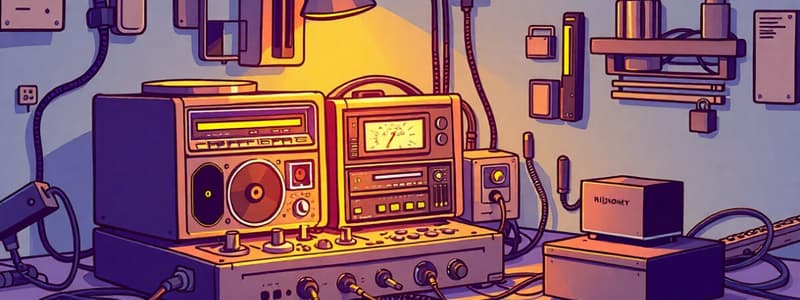Podcast
Questions and Answers
What does a farad measure?
What does a farad measure?
- The frequency of a current
- The strength of an electric field
- The resistance of a conductor
- The amount of capacitance (correct)
What is the SI unit of inductance?
What is the SI unit of inductance?
- Siemen
- Farad
- Ohm
- Henry (correct)
What is insulation used for in electrical systems?
What is insulation used for in electrical systems?
- To provide mechanical support to circuits
- To enhance electric current flow
- To protect conductors from short circuits
- To resist the flow of electric current (correct)
What is the term used to describe the reduction in voltage in an electrical circuit?
What is the term used to describe the reduction in voltage in an electrical circuit?
What is troubleshooting primarily focused on?
What is troubleshooting primarily focused on?
What does the 'Sorting' phase in 5S primarily focus on?
What does the 'Sorting' phase in 5S primarily focus on?
Which of the following best describes the 'Simplifying' stage of 5S?
Which of the following best describes the 'Simplifying' stage of 5S?
In the context of 5S, what does 'Standardizing' involve?
In the context of 5S, what does 'Standardizing' involve?
What is the purpose of 'Sustaining' in the 5S framework?
What is the purpose of 'Sustaining' in the 5S framework?
What type of tool is a screwdriver classified as according to the provided information?
What type of tool is a screwdriver classified as according to the provided information?
Flashcards
5S Application
5S Application
A set of principles for organizing and maintaining a workplace.
Sorting (5S)
Sorting (5S)
The process of removing unnecessary items from a workspace.
Simplifying (5S)
Simplifying (5S)
Arranging tools and equipment in an order that improves workflow.
Screw Driver
Screw Driver
Signup and view all the flashcards
Sustaining (5S)
Sustaining (5S)
Signup and view all the flashcards
Potential Difference
Potential Difference
Signup and view all the flashcards
Voltage
Voltage
Signup and view all the flashcards
Voltage Drop
Voltage Drop
Signup and view all the flashcards
Frequency
Frequency
Signup and view all the flashcards
Insulation
Insulation
Signup and view all the flashcards
Study Notes
Consumer Electronic Servicing NC II
- Module Title: Maintaining and Repairing Audio Products and System
- Introduction: This module covers maintaining and repairing audio products and systems, including required knowledge, skills, and attitudes. Completing this module will help students understand succeeding modules on computer operation.
- Learning Outcomes: This module has three learning outcomes:
- LO1: Preparing audio tools and workplace for maintenance/repair of audio products
- LO2: Diagnosing faults of audio products and systems
- LO3: Maintaining/repairing audio products and systems
- Summary of Learning Outcomes: Upon completion, students will be able to prepare audio tools and workplace, diagnose faults in audio products and systems, and maintain/repair these products and systems.
Technical Terms
- Active State: A condition of a semi-conductor device that's functioning.
- Ampere: A unit of electric current.
- Capacitance: Measures the amount of electric charge stored.
- Conductance: Measures how easily electricity flows.
- Current: The flow of electric charge.
- Decibel: A logarithmic unit expressing the magnitude of a physical quantity.
- Digital: Representing information using discrete values.
- Duty Cycle: The proportion of time a component/system is active.
- Error: Difference between actual behavior and expected behavior/measurement.
- Farad: The SI unit of capacitance.
- Frequency: The number of occurrences of a repeating event per unit of time.
- Henry: The SI unit of inductance.
- Inductance: An electric current flowing in a circuit that produces a magnetic field.
- Injury: Damage to a body caused by an outside force/agent (physical or chemical).
- Insulation: A material that resists the flow of electric current.
- Ohm: The SI unit of electrical resistance/impedance.
- Potential Difference: The amount of work needed to move a unit electric charge.
- Siemen: The SI derived unit of electric conductance.
- Solder: A fusible metal alloy with a low melting point, used to join metal surfaces.
- Troubleshooting: A systematic method for finding and solving problems.
- Voltage: Electrical potential difference between two points.
- Voltage Drop: Reduction in voltage in an electrical circuit.
- Wattage: The SI derived unit of power, equivalent to one joule per second.
Learning Outcome 1: Prepare Audio Tools and Workplace
- Assessment Criteria:
- Work station is clean, meeting company requirements.
- Necessary tools, test instruments, and personal protective equipment (PPE) are prepared according to their use.
- Service manuals and repair information are acquired for reference.
- Equipment Needed: AM-FM radio receiver, AM radio receiver, DVD/VCD player, MP3/MP4 player, professional audio systems (PA), signal generator (AF/RF), analog/digital multimeter (VOM), oscilloscope, power supply, audio frequency counter, distortion analyzer, electronic hand tools (soldering iron, soldering stand), desoldering tool, screwdrivers (Phillips, flat head), pliers (long nose, diagonal), utility knife, cleaning brush, electronic components, soldering lead, wires, silicon grease, soldering flux, requisition slip, PPE (gloves, mask), learning materials, work plan, service manual, IC manual, and learning elements.
Learning Outcome 2: Diagnose Faults
- Assessment Criteria:
- Following the manufacturer's instructions for pre-testing.
- Identifying the system's faults.
- Documenting the diagnostics and testing results.
- Explaining diagnosed defects and faults.
- Conditions: Specific equipment and tools needed for diagnosis.
Learning Outcome 3: Maintain and Repair
- Assessment Criteria:
- Replacing parts/components with correct equivalents.
- Correct soldering of components.
- Adhering to manufacturer's specs during substitutions.
- Completing repairs within set timeframes and adhering to safety regulations.
- Conditions: Required tools, equipment, and accessories are listed.
Studying That Suits You
Use AI to generate personalized quizzes and flashcards to suit your learning preferences.




